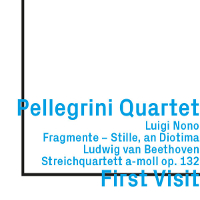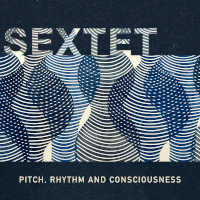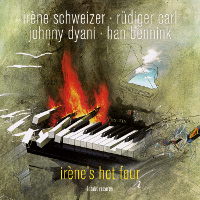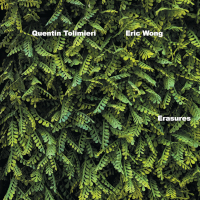Moment's Notice
Reviews of Recent Media
(continued)
Pellegrini Quartet
Luigi Nono Fragmente – Stille, an Diotima; Ludwig van Beethoven Streichquartett a-moll op. 132, First Visit
ezz-thetics 112
 Werner Uellinger’s First Visit series is now augmented by the Pellegrini Quartet’s 1995 disc, originally on Bvhaast, juxtaposing Beethoven’s Op. 132 (1825) and Luigi Nono’s sole quartet, Fragmente – Stille, an Diotima (1980). Even beyond the superb performances of two masterpieces, one of the most inspiring aspects of this reissue involves Art Lange’s liner essay. He describes, in dialectical detail, the personal and political impulses conjoining the two admittedly disparate works, expertly proffering musical histories and the way they reflect the composers’ development but also presenting a potential mode of listening.
Werner Uellinger’s First Visit series is now augmented by the Pellegrini Quartet’s 1995 disc, originally on Bvhaast, juxtaposing Beethoven’s Op. 132 (1825) and Luigi Nono’s sole quartet, Fragmente – Stille, an Diotima (1980). Even beyond the superb performances of two masterpieces, one of the most inspiring aspects of this reissue involves Art Lange’s liner essay. He describes, in dialectical detail, the personal and political impulses conjoining the two admittedly disparate works, expertly proffering musical histories and the way they reflect the composers’ development but also presenting a potential mode of listening.
To that end, on the Beethoven quartet, Lange ruminates: “At some point not simply to be determined the lines of movement were no longer congruent and they became divergent, flooded with memories.” Indeed, and associated complexities of memory and disruption, whether personal, collective or both, become aspects of the tissue connecting the pieces. The Pellegrinis tap into notions of memory and disruption by accentuating contrast. Of course, the movements themselves provide for it, and just listen to the way the quartet transitions from the contemplative third to the jubilant fourth, its rhetorical march figures on full display, to get an idea of their approach. Then, there are the minute transformations within movements, the narrative in microcosm, each poignantly indicative of the whole. Pellegrini only introduces vibrato 28 seconds into the first movement’s glacial opening. Take, for example, the much more recent Cuarteto Casals rendering, where it’s incorporated 15 seconds earlier, or the justly lauded first Lindsay cycle, where it comes into play earlier and much more gradually. Pellegrini creates an Arctic area of staticity, an icy soundscape so close to silence as to thwart facile distinction, simultaneously intimate and vast that vibrato penetrates like a ray of light or moment of warmth. That frozen landscape prepares the motive’s developmental return in octaves, Pellegrini’s revisitation affording an emphasis few recordings manage. They straddle the line between introversion and extraversion in a way that the Emersons’ roughly contemporaneous Beethoven cycle sought but never quite achieved. The Pellegrinis reach an admirable cohesion in music partially constructed to thwart it.
Nono’s only contribution to the medium was commissioned for the Beethoven Festival in Bonn, and, unsurprisingly, makes reference to Beethoven’s A-minor quartet. Lange is quite right to separate notions of reference from quotation, both of which inform what I’ll call Nono’s 36-minute series of fragments. The seeds planted in Beethoven’s Op. 132 bear fruit as Nono’s quartet celebrates its myriad silences. That is, after all, its main mode of expression as the music nears and veers away from the silence fundamental to the act of listening. If the half-step that imbues Beethoven’s main motive, one that he would also transform in Op. 131 and in the “Grosse Fuge,” is readily audible at key moments, they are simply that, angles within angles, disjointed gazes backward as well as inward, points of shared introspection. Shostakovich’s eighth quartet’s three-pronged rapid-fire reports seem to ring out with equal poignancy as the moment-to-moment changes guide the music forward. The only other recording of Fragmente I have heard comes from the ever-estimable Arditi Quartet, set down in a much more resonant acoustic then Pellegrini’s but with a much more transparent production.
Beyond the encapsulation of ideas and all notions of temporal unity or displacement, this is a stunningly beautiful disc. It is often necessary to describe “modern” music with tired cliches, such as “not for the faint-hearted” or “thorny but well worth repeated listening.” The music herein is all of that, but its open-heartedness is always palpable as the earlier composition points the way boldly forward and the more recent engages in the wisdom of innovative reminiscence. Composers and performers are obviously allied in desiring communication, however deep and impenetrable the subject matter. The production is first-rate, a digital recording entirely devoid of the shrillness too often afflicting others of its vintage. In brief, this Pellegrini Quartet disc’s return is most welcome, and may it generate increased interest in a still-underappreciated ensemble and its discography.
–Marc Medwin
Pitch, Rhythm and Consciousness
Sextet
Reva 1005
 For over a decade now, saxophonist Tony Jones and violinist Charlie Burnham have anchored Pitch, Rhythm and Consciousness, a group whose name is also their aspiration. Or perhaps it’s better to say that the first two terms might lead to the third. Both musicians have long years of experience playing improvised music of many different varieties, and both are also practicing Buddhists. This part of their biography is central, not incidental to their music. And with this expanded version of PRC, they aim to place their spiritual concerns fully in the sonic spotlight.
For over a decade now, saxophonist Tony Jones and violinist Charlie Burnham have anchored Pitch, Rhythm and Consciousness, a group whose name is also their aspiration. Or perhaps it’s better to say that the first two terms might lead to the third. Both musicians have long years of experience playing improvised music of many different varieties, and both are also practicing Buddhists. This part of their biography is central, not incidental to their music. And with this expanded version of PRC, they aim to place their spiritual concerns fully in the sonic spotlight.
In the company of percussionist Kenny Wolleson, cellist Marika Hughes, tenor saxophonist Jessica Jones, and bassist Rashaan Carter, they created an intimate, emotional set of music that connects emphatically. Many of the pieces are for smaller sub-groupings of the sextet, though at least as many feature part or all of the music played by the full group. The general vibe is consistent, though, refraining from bombast or overplaying in favor of space, feel, and a bunch of swing.
Like many pieces here, “I Shall Not Want” opens with a gorgeous two-sax grouping, followed by Burnham’s gorgeous violin and pattering brushes. It’s music that sounds familiar, but is anything but stale. I was surprised, though, to hear Burnham’s vocals. He’s in fine voice as he sings Psalm 23. This is followed by a marvelously spacey “The Beginning of the Universe,” with cries from the violin and billows of deep, rubbed percussion. The focus on breath (not just from the horns but from the sound of the arco strings) makes sense given that this account of creation is apparently derived from the Tao Te Ching. It’s not all space, though: after the line “Freedom from the fear of death,” the group digs into some earthy swing. A congregation seems to join in, both vocal and instrumental, in a nice balance of elements, leading to the advice, “Keep your mouth shut, guard your senses; life will always pull you.”
The middle of the record contains a number of fine improvisations, that just so happen to be without text. Burnham’s arch plucking on “Tiny Little Inkling” perfectly matches the delicate metallophone sounds. And I swooned for the Nasheet Waits’ “Kush,” with its gorgeous low strings supported by Wolleson’s tasty brushwork. A lot of this music seems to sit at the intersection of Henry Threadgill’s old Sextett and Billy Bang’s records with William Parker, kind of country avant-blues music. You can hear it in the two-horn warmth of “Fundamental Blue” or the slinky swing of “Trouble.”
The balances shifts just a bit with the hushed dynamism of “Running in the Darkness” and the solemn moments of “Whose Tears Are These.” All the grain and warmth everywhere, it’s just a great tone record. Perhaps fittingly, this is heard with greatest intensity on Jessica Jones’ gorgeous, elegiac “Psalm for a Shared Tomorrow,” where the adapted Jewish liturgical melody results in some of the most sumptuous harmony and expressive playing of the date. Equally stirring is the closing “Prepare a Refuge,” where Burnham’s strongest vocal performance given over to a reading from the Dhammapada. This is wonderful music, creative and emotionally grounding in these ferocious times.
–Jason Bivins
Irene Schweizer + Rüdiger Carl + Johnny Dyani + Han Bennink
Irene’s Hot Four
Intakt CD 438
 Hot Four indeed! Although less a nod to Louis Armstrong’s seminal small bands than an apt descriptor of the combustive energies at play. This newly issued recording from the 1981 Zurich Jazz Festival captures four iconoclasts in a volatile, freewheeling encounter that simmers and erupts, and even occasionally genuflects to jazz history. Pianist Irene Schweizer, reedman and accordionist Rüdiger Carl, drummer Han Bennink, and bassist Johnny Dyani never recorded together in their short existence as a unit beyond this date. Yet their intersections run deep. Carl and Bennink were frequent foils for Schweizer throughout her career, while Dyani, a member of the fabled Blue Notes, shared lineage with Schweizer via her regular collaborations with drummer Louis Moholo-Moholo.
Hot Four indeed! Although less a nod to Louis Armstrong’s seminal small bands than an apt descriptor of the combustive energies at play. This newly issued recording from the 1981 Zurich Jazz Festival captures four iconoclasts in a volatile, freewheeling encounter that simmers and erupts, and even occasionally genuflects to jazz history. Pianist Irene Schweizer, reedman and accordionist Rüdiger Carl, drummer Han Bennink, and bassist Johnny Dyani never recorded together in their short existence as a unit beyond this date. Yet their intersections run deep. Carl and Bennink were frequent foils for Schweizer throughout her career, while Dyani, a member of the fabled Blue Notes, shared lineage with Schweizer via her regular collaborations with drummer Louis Moholo-Moholo.
Though all four compositions are credited to the pianist, Hot Four unfolds as pure improvisation – an open canvas rather than a set of tunes. The absence of predetermined structures invites a kind of democratic navigation, more Art Ensemble of Chicago in spirit than form, though with no particular destination in mind. Any player can – and does – shift the current. While it is Schweizer who often steers the group, it’s Dyani who reorients the trajectory part way through the expansive “Reise” with a muscular two-note ostinato, summoning a lurching, joyful march out of abstraction.
Why this recording languished in the archives for over four decades remains unclear. What is clear is that it now stands as a vital addition to Schweizer’s legacy. Her passing in July 2024 has prompted renewed attention to her pivotal role in European free jazz. A percussive player strongly shaped by Cecil Taylor’s explosiveness and John Cage’s extended techniques, Schweizer also possessed a keen rhythmic sensibility rooted in South African township grooves – absorbed from Abdullah Ibrahim and Dyani himself. That rhythmic foundation gave her an exceptional synergy with drummers, whom she allowed space to embellish, provoke, and swing freely.
The album’s second piece, “Freizeit,” exemplifies Schweizer’s kaleidoscopic approach, as she initiates a left-hand stride figure, refracted through Thelonious Monk and filtered by Taylor’s dissonant clusters. That follows a whimsical prelude of stomps, clatters, and guttural utterances which suggest Bennink at his most puckish. Theatrical interludes like these surface often enough to imply a performance rich in visual granularity, a dimension inevitably lost to time, but happily the audio alone retains enough clarity and momentum to sustain interest.
From the keyboard to the very innards, Schweizer spurs, goads, and scaffolds. Carl veers between vaporous accordion textures and sudden saxophone squalls, repeatedly latching onto concise motifs that acquire weight through repetition. Bennink remains uncategorizable – careening from slapstick to savagery, yet supremely adapted to the ensemble’s shapeshifting mutations. Dyani anchors the quartet with sinewy bass lines, but also wields his bow as a careering accelerant, injecting the quartet’s climaxes with startling propulsion.
The encore distills the concert’s irreverent flow into a bracing coda. A swirl of harmonica, skittering accordion, and detuned piano flares into a galloping maelstrom, capped by Bennink’s final crashed exclamation point. Unpredictable yet cohesive, anarchic but profoundly musical, Hot Four is a belated triumph – more than an archival curiosity, it’s a snapshot of four restless talents in rare and riveting alignment.
–John Sharpe
Quentin Tolimieri + Eric Wong
Erasures
Ftarri 935
 Berlin-based musicians Quentin Tolimieri and Eric Wong are each consummate investigators of sound. Pianist Tolimieri’s recordings have increasingly moved toward the resolute examination of timbral nuances on releases including Piano, Prepared Piano, Soprano Melodica, and Bass Melodica, and more recently, Monochromes, each a contemplation of specific sonic aspects of the respective instruments. Wong describes himself as “a musician and sound artist whose work involves auditory perception and the exploration of human relationships with sonic environments,” working in improvised settings as well as creating sound installations. On Erasures, Tolimieri and Wong scrutinize the interactions of repeated fixed patterns of piano notes and electronic sounds spatialized through the use of Bluetooth speakers, each track methodically paring their respective parts down to their underpinning, sonic elements.
Berlin-based musicians Quentin Tolimieri and Eric Wong are each consummate investigators of sound. Pianist Tolimieri’s recordings have increasingly moved toward the resolute examination of timbral nuances on releases including Piano, Prepared Piano, Soprano Melodica, and Bass Melodica, and more recently, Monochromes, each a contemplation of specific sonic aspects of the respective instruments. Wong describes himself as “a musician and sound artist whose work involves auditory perception and the exploration of human relationships with sonic environments,” working in improvised settings as well as creating sound installations. On Erasures, Tolimieri and Wong scrutinize the interactions of repeated fixed patterns of piano notes and electronic sounds spatialized through the use of Bluetooth speakers, each track methodically paring their respective parts down to their underpinning, sonic elements.
“Erasing” begins with a pulsing sine tone and quietly sounded piano notes, looping in and out of sync with each other. Wong introduces rattling pings and low-end skeins, carefully placing his parts against the spare phrasing of Tolimieri’s piano. There is a patient focus as the two gradually increase the overall sonic density, let the sounds accrue, and then let them diminish as they reverberate in the sonic field, ending with the quietly coursing sine tone. “E as n” begins with the dark, spare lyricism of piano chords placed within Wong’s percussive clicks which are diffused across the stereo field. Wong builds layers with meditative intent against Tolimieri’s patient lyrical swells as the collective sound builds and then dissolves into silence. The final piece, “s n,” starts with an insistently stabbing piano phrase that is tinted with electronic shading. While far more active than the proceeding pieces, the two deploy the same attention to subtle colorations as crackles and shimmering tones are layered against the indefatigable piano patterns. There is a gamelan-like quality to the interaction of brittle piano tone and metallic electronics as the piece wells with stanch deliberation, ending with a shower of piano notes as the electronics drop away. Across the three pieces, the two delve deeply into the interactions of overtones and resonance, acoustics and electronics, and pattern and field which continue to reveal new layers across repeated listens.
–Michael Rosenstein